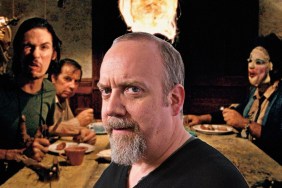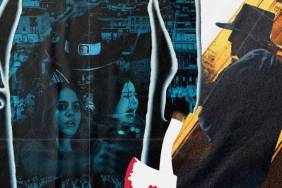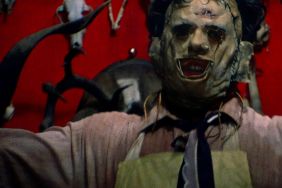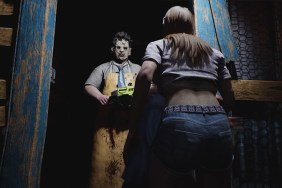A look at director Robert A. Burns’ very personal 1982 canine horror movie Mongrel
In the film’s pre-credits curtain raiser, Mongrel establishes it’s grimy and unnerving mood with a disorientating point of view shot accompanied by heavy breathing that is somehow part human and part bestial – and in turn, this becomes a perfect summary of what this seldom-seen and therefore unfairly underrated gritty take on lycanthropy is all about. The film is a tightly woven character study that could quite honestly be likened to the much-championed masterwork Martin (1978) from George A. Romero – where our anti-hero goes through his alienated existence believing he is a vampire. Mongrel uses the concept and themes of lycanthropy as it’s sturdy skeletal story structure — having the jittery, troubled and tormented protagonist fall victim to the violent outbursts of the condition — but ultimately the film favors an invested interest in the character’s personal relationships, social awkwardness, repressed sexuality and neurosis rather than tipping into full-blown fang bearing, fur sprouting werewolf territory.
There is something remarkably open, honest and revealing in Mongrel, and this is what makes the film even more of a bizarre oddity – it is as if you are watching someone’s confession unfold on screen. What is so telling about this introspective and intimate horror outing is the fact that this film is incredibly personal – it says a lot about the movie’s director Robert A. Burns and what he may have struggled with as an artist as well as a human being. Burns would make a name for himself in horror film history having been the art director on such classics as The Texas Chain Saw Massacre (1973), The Hills Have Eyes (1977), Don’t Go Near the Park (1979) and The Howling (1981). His work on those films is undeniably outstanding and iconic – any dedicated cinephile or horror devotee just has to think back to the dried up bones and hanging ornaments used to deck out the Texan abode occupied by Leatherface and company in the aforementioned The Texas Chain Saw Massacre, or the lupine artifacts scattered around Eddie Quists’s apartment and the animal pelts that decorated his sister Marsha’s cabin in The Howling. But here in his one directorial effort (which he also wrote), Burns somehow delivers an extension of his work as a designer and art director that fundamentally comments on his personality and frustrated desire to “speak”; through Mongrel, it is as if he has finally been given the opportunity to find a “voice.” In many ways, Mongrel is a concentrated and intelligently filtered artistic catharsis that exists to both entertain but also act as an artifact of therapy. Upon viewing the sheer ugliness of the film — which is designed and painted with a sleazy sensibility — you can sense a lot of who Robert A. Burns was as his personality and his attempts at communicating his dynamic ideas pulsate within the makeup of the film.

His expressions of violence are displayed simply – and frankly the sequences involving mutilation and slaughter are completely benign. There is an artistic choice certainly in play here as Burns prefers to disturb his audience with concepts, his lead’s neurotic performance (which is genuinely inspired), the previously-mentioned grotty aesthetics and a foggy examination of mental illness rather than execute extreme gore – which is certainly what many audiences would have expected from the man who decked out Leatherface’s slaughterhouse. However, one must also remind themselves that Tobe Hooper’s American cinema landmark was also almost completely bloodless – relying on mood, tension and the masterfully-handled rhythm of exploiting the notion of onscreen violence rather than showcasing it. Burns is clearly inspired by Hooper’s creative handle on the treatment of celluloid carnage and when he does provide a few moments of visceral brutality it is fleeting and used to close the rather lengthy scenes. One of the deaths in the film is drawn out — having the victim crawl backwards as he is slashed to ribbons — but for the most part, the deaths occur off-screen after wonderfully-constructed stalking sequences would precede them. As a filmmaker, Burns exhibits a wonderful gift for chasing his victims with his camera; in fact a lot of his camera angles and movements are calculated, methodical and sharp, giving the film a taut tension that lasts throughout its stay. Even though the film is a wordy talkfest, there is an underlying unease that simmers just under the surface and this adds to the bleak nature of the piece as well as the mounting terror that is eventually unleashed in the manic finale.
The story involves Jerry (Terry Evans), a neurotic introvert who lives in a shambolic boarding house along with a group of other misfits. Jerry works as an indexer; a tiresome, repetitive and menial job, but he explains that it “can be exciting.” This profession doesn’t hinder his ability to connect to the outside world, in fact, he bonds with the bright-eyed and lovely Sharon (Catherine Molloy) — the most “together” of the live-in residents — by letting her read certain manuscripts that he believes “she might enjoy.” Enter Ken (Andy Tienann) an attractive strapping young man who strikes up both a friendship with the loner Jerry, while slowly developing a romantic connection with the pretty Sharon. One of the strongest and most fascinating elements of the film is the sexuality of the piece and the mark of bisexuality as the foundation of neurosis. Jerry is both attracted to Sharon and Ken and this is made apparent throughout the story. His desperate passions are stunted and never articulated; instead, they confuse him, agitate him, torment him and in a sense cruelly mock him. The handsome and athletic Ken comes to represent what Jerry most admires about men, while Sharon is open, warm, sensitive and nurturing and someone that Jerry can relate to and even love. The way director/writer Robert A. Burns presents the figures of Sharon and Ken takes on a life of its own, as Ken is often seen without his shirt showcasing his muscular lithe body, while Sharon is talked about at first as a beautiful and sweet girl (Ken asks if she is Jerry’s boyfriend, the troubled Jerry quickly remarks “Oh it’s nothing like that!”) who is then introduced to the film through the “gaze” of Ken who remarks “Man, she’s cute!”

Ultimately, Robert A. Burns gives us two characters that represent the “ideal” functional male and female, and he plops the manic and messed up Jerry in the middle rendering the “monstrous” misfit as a bisexual loon. Jerry sits in between two pillars of normalcy and good mental and emotional health – and with the film adopting a massively influential bullying aspect (at the hands of three loathsome residents at the Texas boarding house), Jerry uses Ken and Sharon as crutches that can help him cope with his psychosis. Jerry’s repressed sexuality hammers down upon the mental illness and that pounding sets off a bizarre connection to an aggressive dog that is owned by one of the loutish residents at the boarding house.
Jerry lives in the shadow of trauma, haunted by a terrifying experience he had as a child with a dog. Now, as a young man he is tormented by an agitated large wolfhound that is chained up outside the boarding house. With the dog’s endless barking and ferocity, Jerry becomes increasingly disturbed and something triggers him into a gradual psychotic rage. However, it is human intervention that sends him over the edge. Three men that share residency with Jerry — the oafish Woody (Mitch Pileggi), the sleazy Ike (Jonathan M. Ingraffia) who owns the crazed pooch and the simpleton Toad (John Dodson) — not only pick on the pathetic loner, but they also torment one another. At one point, Toad teases Ike’s dog and it ends badly, with the dog breaking free from his chain and attacking him. Gunned down by Woody, Ike is furious about the slaying of his animal and something almost otherworldly is discharged. Jerry begins to channel the aggression of the deceased dog and all of this becomes full blown when a nasty prank is set on Ken – a prank that ends fatal.
Ken is told that Sharon is waiting for him upstairs in his room and he excitedly heads over. Stripping off and noticing a body lying in his bed, he creeps in and is shocked when he finds that it’s the decaying corpse of Ike’s dog dressed in a negligee. Freaking out and spilling water and hitting a lampshade, Ken is electrocuted and instantly killed. Sharon returns to the boarding house and is mortified, but it is Jerry who is completely devastated. Earlier in the film, he explains to Sharon that Ken had taken him out to dinner and that he “really likes him.” Now, at this turning point in the film Jerry is seen Ken’s limp wet near naked dead body, sobbing inconsolably. Jerry’s passion for Ken is clearly on display and is commented on by Woody saying “You’d think he was in love with the guy.”
Eventually in the film, the heterosexual bond Jerry shares with Sharon is also tested as she sees their union as a loving but strictly platonic one. By the frenzied climax of the film, Jerry feels betrayed by Sharon, and turns on her, lunging at her and attempting to kill her. The sexual aspect of Jerry’s lycanthropy is certainly the most dynamic of the character’s dimensions and Robert A. Burns examines this in a clever and sensitive manner.

Burns also makes profound commentary on American culture within the confides of the boarding house which is completely upholding its own personal politics. For example, Woody is built up to be an America that is completely vulgar, crass, insensitive, insincere and brutish, while Ike is opportunistic and snaky. The most sympathetic of Jerry’s victims is Leon (Daniel Medina), a level-headed effete young man (read as possibly gay – but rendered sexless), who counters the thuggish Woody and the others, while the one female victim of the film, Turquoise (Rachel Winfree) – who is Woody’s flighty girlfriend. She is a left over hippy, a product of sixties counterculture which will eventually (come the mid-eighties) reach mainstream diatribe. When she talks about her organic vegetable garden and fruit smoothies, it is commentary on the burgeoning health craze that would surface in the eighties that would somehow borrow from the hippie movement.
Shot in Austin, Texas (Burns was from Texas and primarily worked from there, apart from trekking out to Los Angeles for films such as The Howling), the film’s prime locale is the boarding house, which is a grungy and filthy building, somewhat reminiscent of its urban relative, the hotel building from the much-loved cult favorite Basket Case (1982). In fact, Mongrel has a thematic likeness to that New York set gore-soaked doozy in that both films deal with a young man tortured and tormented by a divided personality (a relentlessly bloodthirsty “twin”/the spirit of a vicious dog) and are both primarily surrounded by undesirables who “get under the skin.” However, unlike insular splatter fare such as the fun Basket Case which lives by the rule of pitting together a varied group of personalities who all live and co-exist around the central figure, Mongrel is devoid of any humor – it takes itself very seriously, and even when the loutish buffoons play around there is a stoic mean-spiritedness in place.
The talky nature of the piece is excused because the screenplay is in fact very strong. As much as Burns does come across as an outsider in both artistic and personal terms, he does seem to have a great grasp on the human condition and paints up complicated and dynamic characters. If Burns had not died, he would have gone on to make more interesting films as writer/director, but sadly he ended his life after being diagnosed with an inoperable terminal illness. As mentioned earlier, Mongrel is most definitely an acute character study, and even with its primitive edge and basic (and sometimes confusing) premise, the central figure of Jerry is a successful oddball in early eighties horror movie history. He is a complicated mess who channels the unbridled passions and desires of a frustrated and anxiety-riddled canine.









